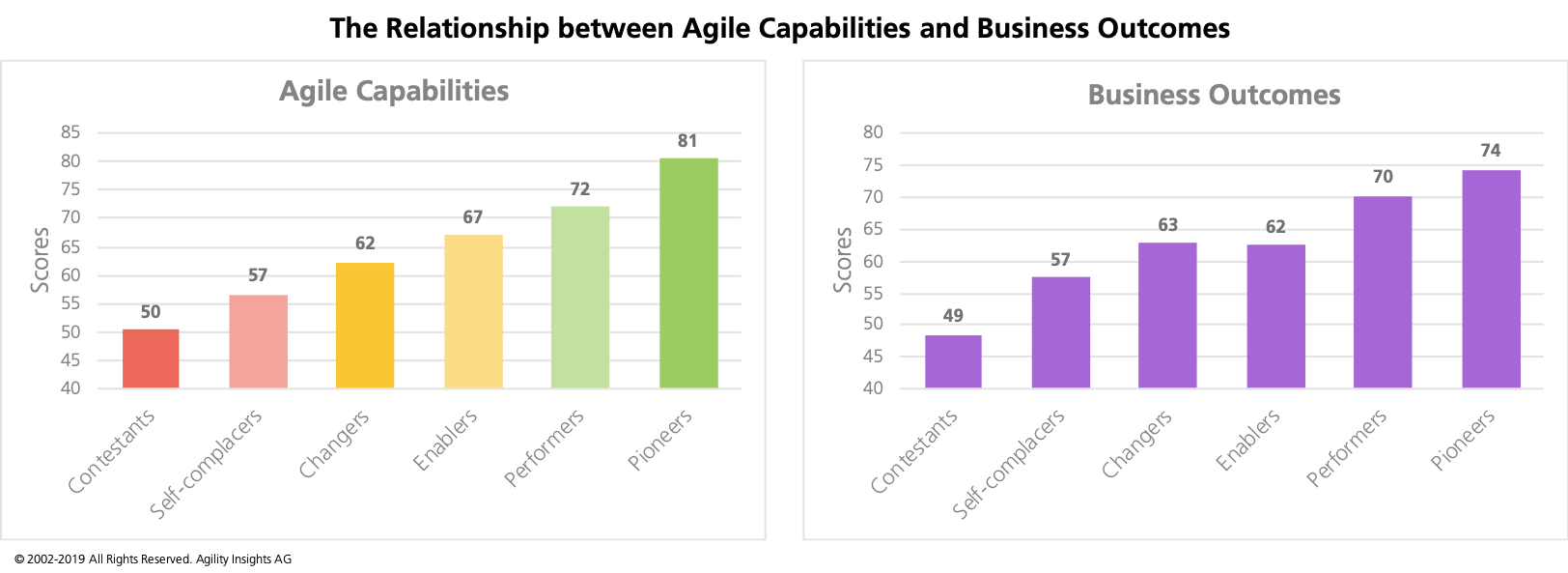
Agile is in fashion. Organisations initiate agile projects and expect to become more agile—often with limited facts to start with. While we are able to confirm that, in general, agile delivers results, not all initiatives meet expectations. But, when the business context turns dynamic, agile is a must when new capabilities are needed for superior outcomes.
Agile has become mainstream in business. It is seen as the general solution for success in a dynamic market context. An abundance of suppliers offers agile fixing services raising expectations on its features and outcomes. Not surprising, the message works. It has reached many executives teams increasingly claiming, ‘we need to be more agile’. Advertising has stretched its messages to the point where agile has become the holy grail for all sorts of problems organisations face these days. Just about every managerial initiative adds agile preceding its action term. We have reached the dangerous point, where just about everything is agile and, therefore, must be successful. It’s time to step back and ask: Does agile matter and when?
"With agile: Why guess if you can know?"
With our track record of explicitly measuring agility and always demonstrating agile impact on business, here is what we have learned over the past 17 years:
First, our data and research support the general claim that agile matters. Organisations with higher levels of agile maturity have developed capabilities that yield superior business outcomes. However, not all agile initiatives lead to better agile outcomes. Moreover, agile differences among organisations are huge.
Second, context matters. In a dynamic market context, organisations develop agile capabilities that yield superior outcomes.
Linking agile capabilities with firm performance is not trivial, and the evidence from published research is slim. There are very few scientific studies available that are published based on sufficient data with an enterprise level scope.
With our scientific research and our 2018 study 'Agile Management', we have looked into the relationship between agile capabilities and business outcomes.
We have used our Agile Maturity scale to identify agile organisations. To determine agile maturity, we have clustered 250 organisations and their scores on 38 capabilities into agile maturity levels. The result was a model with 6 levels, ranging from contestants with little agile capabilities to pioneers with all on agile.

The differences in agile capabilities among organisations are huge with 28 being the lowest Agile Score measured and 92 the highest score. The Agile Score summarises the assessment of all identified agile capabilities between 0, being the lowest, and 100, being the highest score.
The six Agile Maturity levels cluster organisations with distinct sets of agile capabilities. The 38 factors included are based on our research publications and the book, The Performance Triangle, to include items such as culture, leadership, systems, awareness, focus, trust, choice, collaboration, relationships, purpose, and more.
"Differences in agile between organisations are huge."
The improvement from each level to a next level marks a deliberate investment and development step in specific agile capabilities. For example, the investment from Self-complacers to Changers is a distinct leadership initiative. These organisations invest in leadership training and development to enable self-satisfied leaders to eventually embrace change.

With clarity on the agile scale, we correlated agile capabilities with business outcomes. For the purpose of this analysis, we have combined typical agile outcomes such as employee talent use, innovation, and internal growth metrics as business outcomes. It’s the best available indicator to allow for a comparison of organisations at different stages of agile maturity.
Significant regression analysis indicates a strong relationship between agile capabilities and business outcomes. In general, higher levels of agile maturity result in higher business outcomes. Comparing the scores of agile capabilities with business outcomes explains the same story.
"Agile makes a difference to performance, innovation, and growth."
There is one surprise, employee engagement initiatives have all sorts of benefits, but, no measurable impact on the agile score. From various sources, we have learned that employee engagement initiatives positively impact employee satisfaction, and even workplace quality. But, it’s not the initiative to add agile capabilities—in general. Our research shows that organisations that successfully transform from changers to enablers use engagement initiatives that initiate with self-responsibility and not table tennis, the couch, and open space goodies. Self-responsibility is a fundamentally different mind-set. It initiates in the self, supported by enabling leadership.
With these insights, we now need to look at the conditions between the relationship of agile capabilities and business outcomes: Does agile business context matter? To find that out, we do this based on our previous research and publication Under What Conditions do Rules-Based and Capability-Based Management Modes Dominate? We split these organisations into those that operate in a rules-based and a capabilities-based context. Traditional rules-based organisations successfully operate in a stable environment with a controlling management style. Agile capabilities-based organisations have learned to cope with a dynamic environment applying engagement type management styles.

The rules-based organisations’ score for agile capabilities and outcomes are low. They operate in a stable environment where traditional approaches dominate. Their agile business outcomes scores are low, meaning non-agile with a focus on incentive driven talent use, exploitation rather than innovation, control rather than purpose. They measure outcomes in terms of efficiency, quality, and reliability.
In the capabilities-based management mode, the scores for agile capabilities and business outcomes are high. These organisations have developed capabilities that enable people to use their full talent. They have created an organisation that enable innovation and a working environment that stimulates growth. These organisations have proactively reacted to higher dynamics with an enabling style that establishes higher agility and outcomes.
Rather than join the claims on untested ground, we conduct applied research and frequently publishes its findings. ‘Does Agile Matter’ offers a sneak peek on a series of upcoming publications on agile capabilities and results.
Literature
Michel, L. (2013). The Performance Triangle: Diagnostic Mentoring to Manage Organisations and People for Superior Performance in Turbulent Times. London: LIP Publishing.
Nold, H., & Michel, L. (2016). The Performance Triangle: A Model for Corporate Agility. Leadership & Organisational Development Journal, 37(3).
Michel, L., Anzengruber, J., Wolfe, M., & Hixson, N. (2018). Under What Conditions do Rules-Based and Capability-Based Management Modes Dominate? Special Issue Risks in Financial and Real Estate Markets Journal, 6(32).
Nold, H., Anzengruber, J., Michel, L., & Wolfle, M. (2018). Organizational Agility: Testing Validity and Reliability of a Diagnostic Instrument. Journal of Organizational Psychology, 18(3).
Since 2002, we create twins of organizations with the AI-based operating system for dynamic leadership.
Management Insights is an independent and privately owned company with headquarters in Zuoz, Switzerland.
For more information, contact Lukas Michel, founder and author, or our partners across the world.
Experience the free TWIN.

